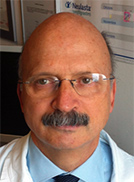Frontline brentuximab vedotin + AVD provides durable benefit over ABVD in patients with stage 3/4 Hodgkin’s lymphoma
Three year follow-up data of the phase III ECHELON-1 trial demonstrate durable benefit of brentuximab vedotin + doxorubicin, vinblastine and dacarbazine (A+AVD) over doxorubicin, bleomycin, vinblastine, and dacarbazine (ABVD) in previously untreated patients with stage III/IV classical Hodgkin’s lymphoma (cHL). After 3 years, 83.1% of patients in the A+AVD arm were alive and free of progression as compared to 76% with ABVD. This benefit of A+AVD over ABVD was seen in patients with a positive and a negative PET-scan after 2 treatment cycles.
Background
Previously, the phase 3 ECHELON-1 study already demonstrated that A+AVD was superior to ABVD as frontline treatment for stage 3/4 cHL in terms of modified progression-free survival (mPFS) per independent review and per investigator. In recent years, we have witnessed a shift in the treatment paradigm of cHL towards a therapeutic strategy that is based on the result of a PET scan after 2 treatment cycles (PET2). However, these PET-adapted strategies also have some shortcomings. For example: short- and long-term toxicities were seen in PET2-positive patients who were switched to BEACOPP, or escalated BEACOPP. In addition, frequent relapses were observed in PET2-negative patients. Three year follow-up date of the RATHL trial demonstrated an overall 3-year PFS rate of 79.8% (82.1% in PET-negative patients). In the SWOG S0816 trial, ABVD in PET-negative patients was associated with a 5-year PFS rate of 76% as compared to 65% with escalated BEACOPP in PET2-positive patients. During EHA 2019, 3-year follow-up data of the ECHELON-1 trial were presented.
Results
In the ECHELON-1 trial, 1,334 patients with untreated stage III/IV cHL patients were randomised (1:1) to A+AVD or ABVD. At the end of cycle 2 a PET scan was conducted (Deauville 1-3 PET-negative; Deauville 4-5 PET-positive) after which patients with a Deauville score of 5 were allowed to switch to an alternative therapy.
At 3 years, the PFS rate in the A+AVD arm was 83.1% as compared to 76.0% with ABVD. This PFS benefit was seen in all investigated subgroups, irrespective of age, IPS score, baseline lymphoma stage, ECOG performance status and the number of baseline extranodal sites. Interestingly, the PFS benefit at 3 years was also seen irrespective of the PET2 result. In PET2-negative patients the difference in 3-year PFS rate was 7.1% in favour of A+AVD (85.8% vs. 79.5%; HR 0.69; p=0.009). In PET2-positive patients this difference was even more pronounced with a 3-year PFS rate of 67.7% with A+AVD as compared to 51.5% with ABVD (difference 16.2%; HR 0.59; p= 0.077). Also in patients younger than 60 years of age A+AVD was superior to ABVD with a 3-year PFS rate of 84.9% with A+AVD and 77.8% with ABVD (HR 0.69; p= 0.008).
At the primary analysis, 67% of patients in the A+AVD arm and 43% in the ABVD arm had peripheral neuropathy (PN). After 3 years of follow-up, 78% of PN cases in the A+AVD arm and 83% of PN cases in the ABVD arm were complete resolved or improved significantly. Of the remaining PN events in the A+AVD arm, 89% were grade 1/2. The median time to complete resolution of PN in the A+AVD arm was 28 weeks.
Conclusions
Three year follow-up results of the ECHELON-1 trial demonstrate that 6 cycles of A+AVD provides robust and durable benefit over ABVD in untreated stage III/IV cHL. This benefit was seen independent of PET2 status, disease stage and IPS. The results obtained with A+AVD in this trial compare favourably to the outcome of PET-adapted strategies without requiring a change of therapy based on PET2 status and completely eliminates the exposure to bleomycin. PN continues to resolve and improve over time with most patients experiencing complete resolution.
Reference
Gallamini A, Straus D, Dlugosz-Danecka M, et al. Frontline brentuximab vedotin with chemotherapy for stage 3/4 classical Hodgkin lymphoma: 3-year update of the ECHELON-1 study. Presented at EHA 2019; abstract S820.


